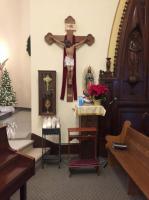Relics To Revere

The Diocese of Evansville is blessed to be home to many precious relics from a vast array of saints. This article is the first in a series that explores diocesan parishes that care for special collections of relics.
One such parish is St. Mary Parish in Huntingburg. In the church’s high altar is a first-class relic of St. Jane Frances de Chantal, who, under the direction of St. Francis de Sales, founded the Visitationist order. The relic is particularly meaningful to the congregation because the parish’s full name is Visitation of the Blessed Virgin Mary. The high altar also houses a piece of St. Francis de Sales’ burial shroud.
The parish’s most revered relics include a relic of the True Cross and a first-class relic of St. Faustina, the Polish nun with whom Jesus shared the Divine Mercy image; these two relics, housed in brilliant gold reliquaries, are permanently displayed in a case at the front of the church for prayer and veneration. On special days, such as Divine Mercy Sunday and the Feast of the Holy Cross, Father Hilderbrand invites parishioners to venerate the relics in a special way. “After Mass, I take the reliquary and bless the people with it and invite them to come forward to kiss the relic,” he said.
The parish acquired its St. Faustina relic as the result of what Father Hilderbrand and parishioners can only describe as a series of events carefully orchestrated by God. In the fall of 2014, on the heels of the Holy Father’s special Year of Mercy, St. Mary parishioner Mona Wagner suggested to Father Hilderbrand that the parish, which has a special devotion to Divine Mercy, attempt to obtain a relic of St. Faustina.
Father Hilderbrand and then-Bishop Charles C. Thompson submitted letters requesting a relic from St. Faustina’s convent shortly before a group of parishioners (among others from the diocese) made a pilgrimage to Poland. Unaware of how the process of obtaining a relic from the convent worked, parishioners made their way to St. Faustina’s convent, the Congregation of the Sisters of Our Lady of Mercy. There, Wagner and others assumed that a relic would be waiting for them. However, once they began talking with a young nun, their hopes began to sink.
The young nun, Sister Gaudia, told Wagner and St. Mary parishioner Steve Ubelhor that the process of receiving a relic usually takes a minimum of six months – those on the committee charged with granting relics read each request carefully and pray about each one for months.
After hearing this news, Wagner and Ubelhor were informed that the sisters had not yet opened Father Hildebrand’s letter. Sister Ignacia, the nun in charge of the relics committee, decided to read the letter then and there. After leaving the room, she returned and told Wagner and Ubelhor that they could take home a relic that day. Ubelhor remembers that Sister Gaudia told the pair, “Jesus has decided that your parish should have this.” “We went from a low to a high,” Wagner recalls.
As Sister Gaudia handed the relic to Wagner, she told her, “Here is St. Faustina. She’s with you now.” Ubelhor emphasizes the holiness of the environment on that day. “The aura in that room was really spiritual . . . the two nuns emanated kindness just by being there,” he said.
Father Hilderbrand is grateful that these relics can provide St. Mary parish with “a constant reminder, constant prayer, and constant intercession,” he said. “We’re so blessed that God has given us these gifts . . . It’s a beautiful and humbling thing.”
He notes that relics teach us in a deep way what it means to serve God on earth. “Part of what made the saints the saints is that they broke themselves down in the service of God,” he said. “Mystically speaking, the mere distribution of a relic symbolizes the way a saint lives his or her life: by being torn apart.”
Father Hilderbrand hopes that the relics remind parishioners of their own special missions to be Christ for others, as relics present the faithful with a “call to imitation”: We’re called to break ourselves up – our own desires and passions – and embrace God’s will for us. Dying to self involves being broken up.”


